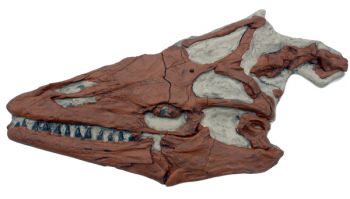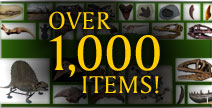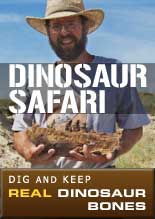
Mosasaurs were a group of predatory marine reptiles that were very successful during the Late Cretaceous Period. The first mosasaur fossils were found in the 1770's in a mine in the Netherlands, more than 50 years before the first dinosaur bones were found. Mosasaurs were among the first fossils recognized and scientifically described. "Mosasaur" means "reptile of the Meuse," a river near the quarry where mosasaurs were first found.
Mosasaurs were highly adapted for living in the sea. Their four legs were modified into paddles which aided in steering. The tail was the primary means of locomotion. Being a highly successful predator, mosasaurs possessed many adaptations for capturing prey. A mosasaur's jaw could "unhinge," much like a modern snake's to swallow larger prey whole. Its mouth was armed with an array of teeth designed for piercing and holding onto its prey. Mosasaurs were even equipped with an extra set of teeth in the ptergoid bones in the roof of the palate. These extended back into the throat and further prevented prey from escaping while being swallowed. It is likely that mosasaurs became extinct along with the dinosaurs during the extinction event at the end of the Cretaceous Period. Modern relatives of mosasaurs include varanid lizards (Komodo dragons, monitor lizards, etc.) and possibly snakes.
During the Late Cretaceous, North America was divided by a great inland sea (known as the Western Interior Seaway) which stretched from the Gulf of Mexico to the Arctic Circle. Vast layers of chalk were deposited in this shallow sea, leading to remarkable preservation of its inhabitants. The chalk beds of western Kansas, known as the Niobrara Formation are world famous for yielding some of the finest fossils of Late Cretaceous marine and flying reptiles, birds, fish, sharks, and invertebrates.
This replica is a Platecarpus ictericus skull. The original fossil was found in the Late Cretaceous deposits of the Niobrara Formation of Western Kansas. The 80 million year old skull belonged to a creature that must have been about 12 feet in total length. Of the three genera of mosasaurs most commonly found in the Kansas chalk (Platecarpus, Clidastes, and Tylosaurus), Platecarpus is the best known. Feeding primarily on fish and invertebrates, Platecarpus was one of the dominant predators of the Western Interior Seaway.
Resin
32x17 inches
Item 2412
Category: Replicas
Type: Skulls
Phylum: Vertebrates
Class: Reptiles

Now Over 1,000 Items!
PrehistoricStore.com offers the largest selection of replica fossils and other fossil-related products anywhere in the world!
Download a Full Catalog (3MB PDF)
OVER 260 PAGES OF REPLICAS AND MORE!
